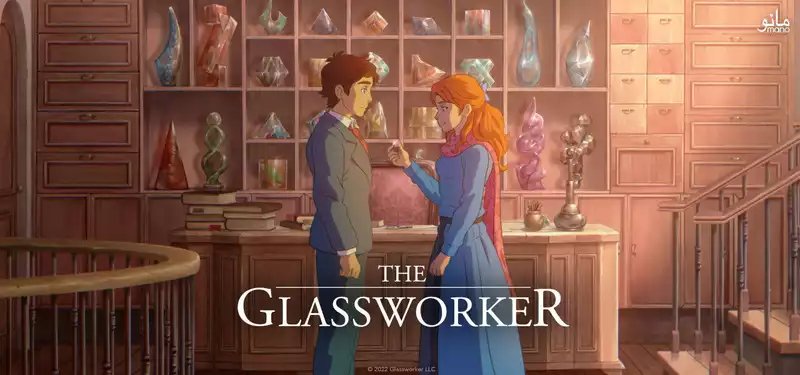Jun 21, 2022
Meet the team behind Pakistan's first traditional feature-length animation "The Glassworker" - Exclusive Video
"I am ready to go to the ends of the earth to make this happen." When these words come out of Usman Riaz's mouth, you know he means it. Riaz is the director of Pakistan's first traditional 2D feature animation, The Glassworker, and co-founder of Mano Animation, a studio he and his team started from scratch to make their dream a reality.
In Annecy this year, Cartoon Brew discussed their journey so far, what inspires them, the challenges of starting a studio in Pakistan, their deep perseverance, and how close they are to completing their film.
The full conversation can be found here:
The influence of Studio Ghibli is evident in the artwork for "The Glassworker" released so far. As Usman states in an interview, "Studio Ghibli is a big inspiration. They are my heroes." In fact, Riaz owns many of the art books released for the feature films of Hayao Miyazaki and Isao Takahata. He says, "I learned a lot about filmmaking from them."
Similar to the method used by Hayao Miyazaki himself, Riaz drew all the storyboards for "Glassworks. However, "I am not Hayao Miyazaki or Mamoru Hosoda. I drew all the storyboards myself, but I had the script."
Mano Animation provided Cartoon Brew with exclusive access to the film's showreel as a means of demonstrating what they had accomplished so far.
In discussing how he prioritizes story, Riaz shares his underlying belief that he wants to get every part of the film right. 'The story is important. I love animation. But if the story behind the animation is hollow, then it's just a lot of pretty pictures."
Riaz also believes that "the story is the most important part of the film.
It is one thing to create rich, original stories, but it is quite another to establish a studio that deals exclusively with traditional animation techniques in a country with no historical tradition.
Therefore, Riaz asked those close to him to join him in his venture, including his cousin Kaiser Riaz as producer and his childhood friend Maryam Paracha as art director. Both share his vision.
Paracha explains, "Usman has a tendency to draw people in and not let go. Together they set up a studio and began to figure out what it would take to make an animated feature film.
Kaiser said, "We had to come up with everything ourselves. [Usman taught himself how to draw storyboards and Aamir, the animation director, reverse engineered how to draw animation. The production was the same," he said. [Gathering talent for 2D animation in Pakistan was also not a simple task. Traditional animation is a tough and highly technical field, and when the Mano Animation staff put out a call for artists, they were surprised to receive replies from doctors and dentists who wanted to switch from their existing careers to work on the film.
The response from these professionals was amazing, but often the biggest challenge was convincing their parents that a career in animation was possible in Pakistan. Usman recalls, "We would spend days at a time at the studio, evaluating what the parents were doing and seeing if it was worth it for their children to take the plunge. It is very difficult to ask that of someone else. Your child has a track record of success, and you're asking them to throw it away."
The passion that Riaz and his team demonstrated to parents eventually persuaded many of them to bring their children into the studio. As Usman recalls, "One dentist father was in the studio and was constantly arguing with us that this was not a good idea. Your children are very talented, please let them pursue their dreams. After about a day of talking with Khizer, Mariam, and me, he went out and said to my daughter, 'You know what? 'These people look so crazy, and they are so into this technology, you should work here.'"
"I hope this is the beginning of a tradition in Pakistan to make more films like this and encourage more kids who want to become doctors to become artists. I hope," Paracha says.
"I hope this becomes a Pakistani tradition and more films like this are made to encourage more kids who want to be doctors to become artists," Paracha says. That is our dream."Making an animated film is an art, but the key to success for any film is raising funds and eventually selling the finished product for worldwide distribution. At the summit in Karachi, the team met Rachna Abdi. She introduced us to her college friend and top Spanish animation producer Manuel Cristobal ("A Wrinkle," "Buñuel's Labyrinth"). Paracha said, "We Googled him and were like, "This is Manuel Cristobal." ...... Obviously, we knew him. Because 'Wrinkles' was the first [international] film Ghibli bought to see in Japan," he recalled."
"I thought I was just going to be polite and talk, and here we are," laughs Cristobal from Annecy.
He is now the executive producer of The Glassworker. Says Cristobal. 'I was fascinated by Usman's work. After his presentation [in Annecy], there was a standing ovation. What I saw in Usman, his team and the film is what the audience saw."
Cristobal, an experienced producer, warns that talent alone will not get you this far. 'I think that's one of the things talent has to understand. Apart from talent, you have to put your own blood into the film." That, he believes, is what the Mano Animation team does every day. In fact, on Monday morning, the day after their trip to Annecy, the team was back in the studio continuing work on "The Glassmaker."
As Rias puts it, "This film is a labor of love. This film is a love letter to the films I grew up watching and the films I love. I hope people find something to love in our film."
.



Post your comment